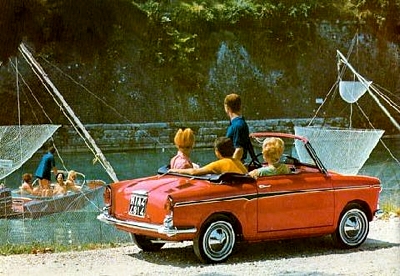Autobianchi
|
1956
- 1966 |
Country: |
 |
|
Although the name of Autobianchi derives from the long-established Fabbrica Automobili Velocipedi Edoardo Bianchi Co, the Italian concern had no direct connection with its predecessor.
Edoardo Bianchi's firm was founded in 1885, in the first place to manufacture bicycles; like many other cycle manufacturers, they soon graduated to building cars, and the name of Bianchi became well-known in Italy in the years between 1905 and 1939.
After the war, however, the company found great difficulty in getting back into car manufacture, and in 1954 the engineer Ferruccio Quintavelle succeeded in interesting Fiat and Pirelli in the production potential of the factory at Desio, and in the prestige of the company's name.
In January 1955 a new company was formed, Bianchi, Fiat and Pirelli each holding one third of the shares. In September 1956 the rundown of Bianchi's Desio factory began, but it was not until June 1958 that Autobianchi formally acquired the premises.
This period saw the final financial crises of Bianchi, the dismissal of Guiseppe Bianchi as managing director of Autobianchi, and the division of the shares of the company between the two surviving partners. It is easy to understand Pirelli's reason for their investment: they had found a new outlet for their tyres.
Fiat's reasons are not so clear. Their aim seemed to be to produce an extension of their own car range, designed for people 'who want to be noticed'. They also wanted to produce models with, at that time, such experimental features as front-wheel drive, without being bound by their trademark.
The Fiat 500-based car, known as the Bianchina, was unveiled in September 1957, but distribution did not begin until the early months of 1958. In true Bianchi tradition, the new car employed conventional techniques in a model offering greater distinction and comfort than the low-priced Fiat version from which it derived its major components and inspiration.
In the Bianchina's first year of production, 11,000 cars were manufactured at the Desio plant. The model's success was indisputable and this fact led to the announcement of a new range, based on the original model: the Bianchina Special came on the scene, as did the four-door normal and special variants, the Panoramica, the Cabriolet and the small-van version.

1967 Autobianchi Cabriolet.

Autobianchi A112 Abarth.
|
In 1964, an engineer called Giovanni Nasi took over the chairmanship of the company, showing the first sign of the complete Fiat takeover which was approaching. In the autumn of that year, the Primula appeared. Again, this employed standard Fiat components, in this case derived from the Fiat 1100, and used in a distinctive way.
The Primula, with its transverse engine and front-wheel drive, served two purposes. It introduced a mechanical formula with which the Italians were still unfamiliar and it provided the Fiat organisation with a practical proving ground for ideas which were to be much further developed in the years ahead.
Pirelli Withdraws
The Pirelli group withdrew from the company in 1968 and Autobianchi was merged with Fiat while continuing to retain its autonomy and its own independent production line. The following year, the Desio factory was enlarged and production of the Fiat 500L was added to the range.
In 1970, two new Autobianchi models were introduced. One was the A111, a small, de-luxe, four-door development of the Primula, offering to the public a more expensive, better equipped and more powerful alternative to the Fiat 128, from which it was evolved. The other was the A112, a delightful, quality small car with a 903 cc engine producing 47 bhp.
This proved to be the forerunner of the 127, which emerged in the Fiat range a year later. The elegant A112 achieved notable success in the Common Market counrties. Small dimensions, brisk performance, excellent
handling characteristics and good quality finish and equipment gave it a place in the market for which there was little competition.
Such was the demand for the A112 that in 1972, production of the A111 ceased. The additional manufacturing capacity thus created was used for the A112. Since 1973 three models were produced side by side.
In 1976 the range included the luxurious elegant and the sporting Abarth models. A very small but highly economical and typically practical Fiat 500 based estate, the Bianchina Giardiniera completed the range, reflecting the fact that, while retaining its own identity, the company, like many in Italy, was very much an integrated part of the Fiat empire.
The A112 continued for a remarkable 17 years, with frequent but rarely insubstantial changes. After over 1,250,000 of those small cars were built, they were finally replaced in 1986 by a new model, the Autobianchi Y10, based mechanically on the Fiat Panda. This car was branded as Lancia from the beginning for most export markets (except for France again, until 1989), thus becoming better known as the "Lancia Y10". It retained Autobianchi badging and branding in Italy alone. The Desio plant was finally closed in 1992 and with the Y10 being replaced by the Lancia Ypsilon (branded as Lancia in all markets including Italy), the Autobianchi brand disappeared altogether in 1996. The rights to the brand are now held by the Registro Autobianchi, the official club of the marque in Italy.



